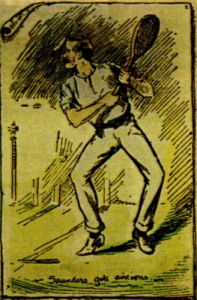In the Dedans
Clare Bucknell
Leamington Tennis Court Club was established in 1846, which makes it the world’s oldest real tennis club: not the oldest real tennis court, which is at Falkland Palace in Fife (built in 1539, open-roofed, unplayable in rain), but the oldest private members’ tennis club. Women were admitted as members in 2008 and there are reminders everywhere of the club’s 160-odd years without them. There’s a large oil painting hanging in the lounge of an exhibition doubles match: every one of the four players and fifty or so spectators is in trousers and has an imposing moustache.
Real tennis is a sport for hand-eye co-ordination masochists. The ball is rock-solid and the racquet head is tightly strung and very small; there are odd corners and buttresses and roofs, which are different on every court; and an unnervingly complicated ‘chase system’ for determining the service. It has a richly absurd history: choristers and schoolboys using their hands to hit balls made from discarded monastic robes against cloister walls during the Middle Ages; Henry VIII playing a match at Hampton Court while Anne Boleyn knelt on the scaffold; the glittering society around the game in fin-de-siècle England and America; and now me, in mismatched whites, doggedly hitting forehands at a painted wooden picture of a unicorn.
I’ve been playing for almost three years. Last month I went to Leamington to compete in the Ladies Real Tennis World Championships, held every two years and in the UK every eight. Most of the players come from the UK, France, the US and Australia. Around 10,000 people play the game worldwide; there were 52 competitors at Leamington. There are singles and doubles draws, a singles plate competition for players knocked out by the top seeds in the first round, and a handicap doubles competition in which – as in golf – a system of penalties levels the playing field between top-ranking players and those further down.
I entered the main doubles draw and the handicap doubles with my partner from Oxford. It became clear as we progressed through the rounds that there was a real tennis ‘circuit’ and we weren’t yet on it. The seasoned competitors were intimately acquainted with each other’s handicaps, game plans and mental weaknesses. They wore whites with things like ‘Queen’s Club 1993’ embroidered on the sleeve. They gossiped in the dedans, both a target area for scoring points and a viewing gallery: spectators are separated from the smack of the ball by a thin piece of netting. Between my games I sat there watching top international players. They struck the ball with a grace and clarity that made it all look shamefully easy. There shouldn’t have been time to do what they did with the racquet at the speed they were moving, but somehow there was time, or they made time.
I was as surprised as anyone to find myself still there at the weekend, in the final of the handicap doubles competition. But it didn’t quite go to plan and I was cruelly robbed of my only chance to be world champion of anything.

Comments